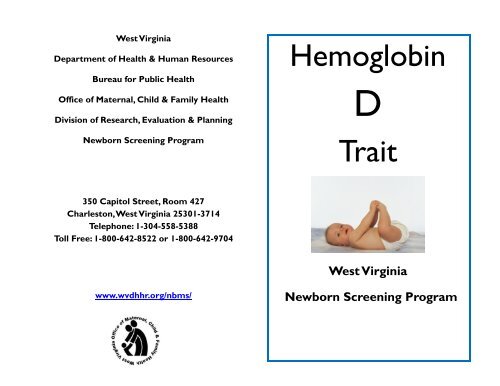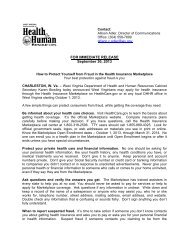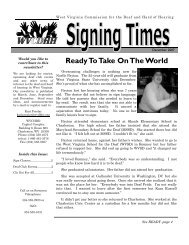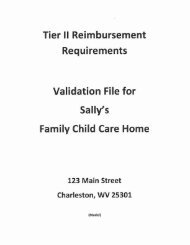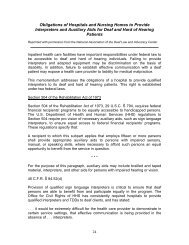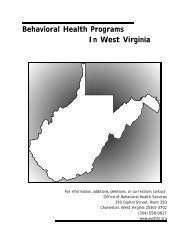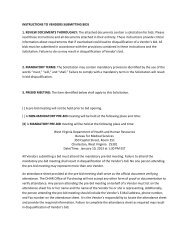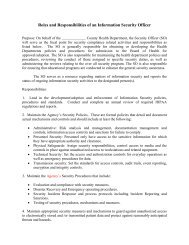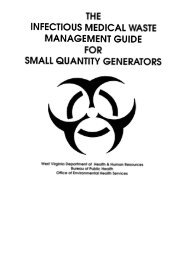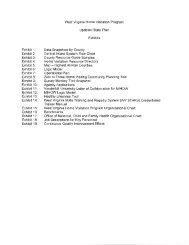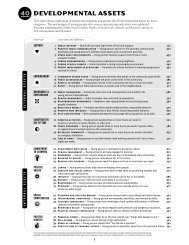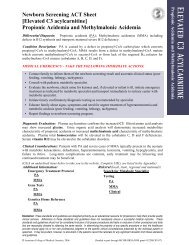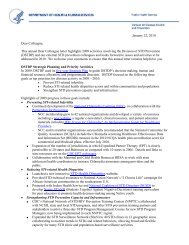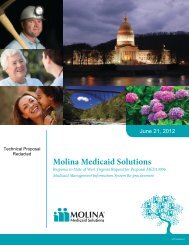Hemoglobin D trait - DHHR
Hemoglobin D trait - DHHR
Hemoglobin D trait - DHHR
Create successful ePaper yourself
Turn your PDF publications into a flip-book with our unique Google optimized e-Paper software.
West VirginiaDepartment of Health & Human ResourcesBureau for Public HealthOffice of Maternal, Child & Family HealthDivision of Research, Evaluation & PlanningNewborn Screening Program<strong>Hemoglobin</strong>DTrait350 Capitol Street, Room 427Charleston, West Virginia 25301-3714Telephone: 1-304-558-5388Toll Free: 1-800-642-8522 or 1-800-642-9704West Virginiawww.wvdhhr.org/nbms/Newborn Screening Program
What is hemoglobin?<strong>Hemoglobin</strong> is part of the blood that carries oxygen to all partsof the body. The usual type of hemoglobin is calledhemoglobin A. Genes that we inherit from our parentsdetermine what type of hemoglobin we have.What is hemoglobin D <strong>trait</strong>?<strong>Hemoglobin</strong> D <strong>trait</strong> means that your child has inherited onegene for the usual hemoglobin (A) from one parent and onegene for hemoglobin D from the other parent. <strong>Hemoglobin</strong>D <strong>trait</strong> is not a disease and does not cause any healthproblems.What if a person has two hemoglobin D genes?When a child inherits the gene for hemoglobin D from bothparents rather than hemoglobin A, that child has homozygous(the same genes for) hemoglobin D. People with homozygoushemoglobin D have no serious health problems, but it maycause a mild anemia (low number of red blood cells).Why was my child tested for hemoglobin D?The Newborn Screening Program screens all infants born inWest Virginia for certain disorders, including hemoglobindisorders. A small amount of blood was collected from yourinfant’s heel and sent to the State Laboratory for testing.Other abnormal hemoglobin types are also detected.What is hemoglobin sickle D DiseaseYour child does not have hemoglobin sickle D disease, butfuture children and other family members may be at risk forhaving it. When a person has hemoglobin sickle D disease,they do not inherit any of the usual hemoglobin A; they inherita hemoglobin S gene (sickle hemoglobin) from one parent and ahemoglobin D gene from the other parent. This is a form ofsickle cell disease. <strong>Hemoglobin</strong> sickle D disease is a seriousillness requiring regular medical care. There is currently nouniversal cure.What do I do now?We recommend that you and your partner have testing todetermine your hemoglobin status. This would provide youwith information on your chances of having a future child withhemoglobin sickle D disease. To have this testing done, talk toyour health care provider.What if I have questions?If you have more questions, you can talk with your child’shealth care provider or for additional information aboutnewborn screening or to find a current list of all disordersthat are screened in West Virginia, go towww.wvdhhr.org/nbms/.If hemoglobin D does not cause any healthproblems, why do I need to know that my childhas it?It is important to know about your child’s hemoglobin D statusbecause future children in your family, or other familymembers, may be at risk for having hemoglobin sickle Ddisease, a very serious disease described on the next page.People with hemoglobin D <strong>trait</strong> or homozygous hemoglobin Dcan pass the gene to their children.


